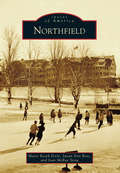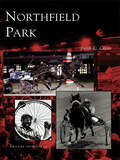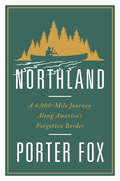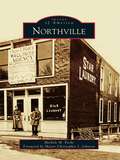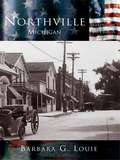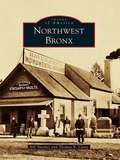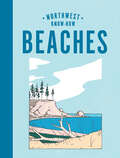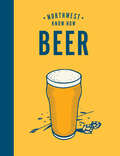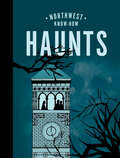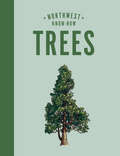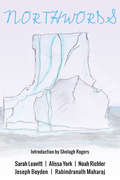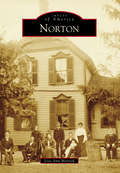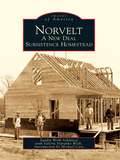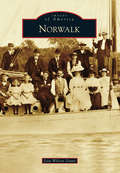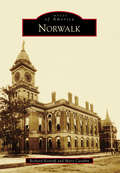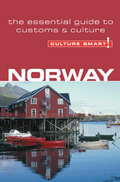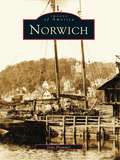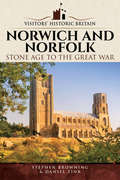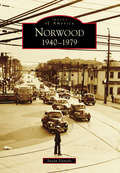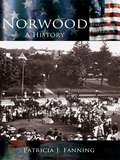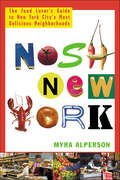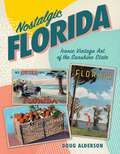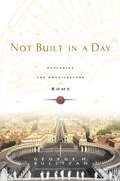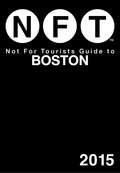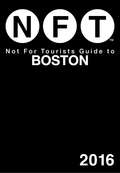- Table View
- List View
Northfield (Images of America)
by Marie Booth Ferré Joan Mcrae Stoia Susan Post RossNorthfield's mountains, abundant forests, and rich agricultural fields along the Connecticut River sustained native inhabitants for centuries before the English settled in the area known as Squakheag in 1713. Incorporated in 1723, Northfield became a crossroads for travel and commerce, supporting ferries, taverns, mills, and other farm-related businesses. Elegant Federal-style homes crafted in the 1800s by the Stearns brothers still line the iconic Main Street. Northfield native Dwight L. Moody, a famous evangelist, founded area schools and summer conferences. In the late 19th century, the quiet farming town became "heaven on earth" to Moody's followers, who arrived by the hundreds each summer seeking spiritual renewal and relief from the cities. The railroad brought visitors to the first American youth hostel and to the popular Northfield Inn and Chateau, where many permanent residents found employment. Around Northfield, Queen Anne-style homes provided lodging for boarders, while tearooms, milliners, liveries, and grocers served visitors. Today, Northfield's vitality and spirit endures, forged by education, hard work, civic engagement, and perseverance.
Northfield Park (Images of Sports)
by Keith L. GisserFrom Al Capone and dog racing, to midget car and harness racing, the history of Northfield Park is one of the most colorful in the standardbred sport. A half-mile track located mid-way between Cleveland and Akron, Ohio, it has hosted the greatest drivers and horses in harness racing since its founding in 1957. From modest beginnings, the track now races 220 live race cards every year, providing a consistent racing schedule for patrons on-site and across North America via simulcast. This book details in both words and pictures the history of the storied oval known as The Flying Turns.
Northland: A 4,000 Mile Journey Along America's Forgotten Border
by Porter FoxA quest to rediscover America’s other border—the fascinating but little-known northern one. America’s northern border is the world’s longest international boundary, yet it remains obscure even to Americans. The northern border was America’s primary border for centuries—much of the early history of the United States took place there—and to the tens of millions who live and work near the line, the region even has its own name: the northland. Travel writer Porter Fox spent three years exploring 4,000 miles of the border between Maine and Washington, traveling by canoe, freighter, car, and foot. In Northland, he blends a deeply reported and beautifully written story of the region’s history with a riveting account of his travels. Setting out from the easternmost point in the mainland United States, Fox follows explorer Samuel de Champlain’s adventures across the Northeast; recounts the rise and fall of the timber, iron, and rail industries; crosses the Great Lakes on a freighter; tracks America’s fur traders through the Boundary Waters; and traces the forty-ninth parallel from Minnesota to the Pacific Ocean. Fox, who grew up the son of a boat-builder in Maine’s northland, packs his narrative with colorful characters (Captain Meriwether Lewis, railroad tycoon James J. Hill, Chief Red Cloud of the Lakota Sioux) and extraordinary landscapes (Glacier National Park, the Northwest Angle, Washington’s North Cascades). He weaves in his encounters with residents, border guards, Indian activists, and militia leaders to give a dynamic portrait of the northland today, wracked by climate change, water wars, oil booms, and border security.
Northville
by Mayor Chris Johnson Michele M. FechtMost of the first pioneers came from New York by steamship across Lake Erie, disembarking in Detroit in the 1820s. From Detroit, it would take three days of treacherous travel through dense forests, thick brush, and swampy countryside to reach their destination--a hilly region in the northwest corner of Plymouth Township that would come to be called Northville. In the nearly 200 years since the first pioneers cleared the land and established their homesteads, Northville has distinguished itself as one of southeast Michigan's most desirable communities. Its rich historical heritage and small-town charm are evident in the stately Victorian architecture of the city's vibrant downtown and tree-lined neighborhoods. Surrounded by the rolling hills of adjoining Northville Township, the community has been shaped by generations of stakeholders committed to creating and maintaining Northville's picturesque and prosperous identity. Throughout its storied history, Northville has been home to the world's largest manufacturer of school furniture, the site of aviation pioneer Eddie Stinson's aircraft company, and the location for one of automotive legend Henry Ford's first village industries, the Northville Valve Plant.
Northville, Michigan
by Barbara G. LouieLocated only a short distance from the cacophony and activity of Detroit's metro area, Northville has maintained its unique small-town charm and identity across the passing decades. Even before the town's official incorporation in 1955, Northville's citizens worked tirelessly to preserve their picturesque setting in rural western Wayne County, to maintain the elegant Victorian architecture in their homes and businesses, and to carve out a prosperous community, marked by excellent schools and a high quality of life. Northville, Michigan brings to life, through word and image, the different events and eras that shaped this small town's history and recalls the area's notable personalities and influences, such as auto industry legend Henry Ford, aviation pioneer Eddie Stinson, and Wayne County Road Commissioner Edward Hines, and their impact on the general character of the community. Most importantly, this volume highlights the everyday person's existence in the Northville of yesteryear, providing today's readers a rare opportunity to glimpse into the lives and worlds of their ancestors and to experience firsthand how they worked, how they worshiped, and how they played.
Northwest Bronx (Images of America)
by Bill Twomey Thomas X. CaseyNorthwest Bronx is home to Wave Hill, Van Cortlandt Park, Woodlawn Cemetery, the New York Botanical Garden, and a variety of colleges and universities. Hunter College served as a training facility during World War II, and Mark Twain, Theodore Roosevelt's family, and Arturo Toscanini once lived at Wave Hill. Pres. John F. Kennedy's boyhood home is only steps from Wave Hill, and George Washington slept at the Van Cortlandt Mansion. Northwest Bronx features an array of vintage photographs of the borough's neighborhoods, from Spuyten Duyvil, Kingsbridge, Riverdale, and Woodlawn to the neighborhoods north of Fordham Road and west of the Bronx River.
Northwest Know-How: Beaches
by Rena PriestEntertaining, educational and highly giftable, Northwest Know-How: Beaches showcases the majestic, quirky, and unique beaches of the Washington and Oregon coastline through facts, history, legend, and lovely illustrations.There are few things more treasured in the Pacific Northwest than its beaches. This celebratory guide features more than 30 favorite coastal and island beaches in Washington and Oregon, providing tips for visiting, fun facts, natural history, and native lore. Charming illustrations will capture the roar of the surf, the call of the wildlife, and the beauty of our beaches. Sure to delight the avid beachcomber and curious visitor alike, this makes the perfect gift and guide for PNW beach-lovers and nature enthusiasts.
Northwest Know-How: Beer
by Jacob UittiNorthwest Know-How: Beer is your crash course on all that is malty and hoppy in the Pacific Northwest. From the brewing basics and local lore to resident brewers and their standout drafts, explore the world of PNW craft beer with this engaging guide.Craft beer is a nationwide movement, and in the upper left corner of the country you will find some of the most passionate and dedicated producers around. Northwest Know-How: Beer is an ode to the region's brews, equipping readers with interesting facts, brewery origin stories, and resources for connecting with other beer enthusiasts. For the uninitiated, this will be a great primer for getting to know the area, and for aficionados it will be a delight to see callouts to local classics and hot spots on the rise!
Northwest Know-How: Haunts
by Bess LovejoyEntertaining, educational and highly giftable, Northwest Know-How: Haunts showcases the haunted hotspots, cemeteries and graveyards, ghost towns, and curiosities in Oregon and Washington.True crime and the supernatural are more popular than ever and Northwest Know-How: Haunts explores the ghosts, legends, and haunted spots of the Pacific Northwest. From the many haunted spots of Seattle&’s Pioneer Square and Pike Place Market to Oregon&’s many haunted hotels, lighthouses, and theaters, this book uncovers the events that inspired the hauntings as well as the reports of the hauntings themselves. Read about the ghost of Simon Benson, a teetotaling spirit who has been known to knock over drinks at his namesake Benson Hotel in Portland. And discover why it might be prudent to steer clear of the honeymoon suite at the Columbia Gorge Hotel. Spectral sightings extend to the water as well: a ghost ship appears off Seattle&’s Pier 70…and reputedly foretells doom. Haunts will be a must-have for anyone who likes their history with a side of spooky.
Northwest Know-How: Trees
by Karen Gaudette BrewerAn entertaining and educational guide, Northwest Know-How: Trees introduces 54 of the Pacific Northwest's most engaging and impressive varieties, providing key identification features, statistics, facts, and beautiful line-art renderings of the awe-inspiring sentinels that dot our landscapeTrees in the Pacific Northwest are as varied as they are majestic. This celebratory guide features 54 of the most intriguing varieties in the region, providing identification tips, statistics, and fun facts for each. In addition, each profile will be paired with beautiful illustrations showing the full silhouette along with finer details such as a flower or leaf. Delighting both the curious observer and experienced arborist alike, this collection makes a perfect gift for the tree lover in your life.
Northwords (Northwords)
by Alissa York Noah Richler Rabindranath Maharaj Joseph Boyden Sarah LeavittNorthwords is a cross-platform project that takes urban Canadian writers Joseph Boyden, Sarah Leavitt, Rabindranth Maharaj, Noah Richler, and Alissa York to some of the world’s most extreme environments, to join the conversation about the north. Introduced by award-winning journalist and radio personality Shelagh Rogers, Northwords is a collection of stories written by acclaimed Canadian authors as they experienced one of Canada’s most awe-inspiring northern national parks Torngat Mountains National Park, the country’s newest national park, and a place steeped in geological and human history. The cross-platform project, which includes a documentary film that follows the authors as they explored the harsh and stunning terrain, had adventures, and created these new works, adds to the continuing story of the North. The stories explore the idea of the North, and what happens when the country’s best writers tackle its most overwhelmingly beautiful places. Taking advantage of opportunities presented by transmedia integration, users can experience the stories in the writers’ own words through Anansi Digital, as well as learn more about their processes and what inspired them through interactive content. Users will have access to film and audio content, and together, these related media will create a larger story web, allowing the audience to truly immerse themselves in the sights, sounds, and stories of the North.
Norton
by Lisa Ann MerrickNorton Township was named for proprietor and principal landowner Birdsey Norton, a wealthy merchant from Goshen, Connecticut. However, he never set foot in Norton--he died six years before the township was organized in 1818. Early settlers, the first of whom were James Robinson and John Cahow, carved their way through the wilderness to build on this fertile land. In its early form, Norton included seven small hamlets: Loyal Oak, Western Star, Sherman, Johnson's Corners, Norton Center, Hametown, and New Portage. Each hamlet had its own unique shops, taverns, blacksmiths, and mills. These communities were home to familiar local names like Seiberling, VanHyning, Harris, Miller, Oplinger, and Breitenstine. By 1961, Norton had become recognized as a village, and by 1968 its growth warranted the designation of city. Early businesses, local schools and churches, aerial views, accidents, and intrigue can all be found within the pages of Images of America: Norton.
Norvelt: A New Deal Subsistence Homestead
by Sandra Wolk Schimizzi Michael Cary Valeria Sofranko WolkIn 1933, the town of Norvelt became the fourth of 99 planned subsistence homestead communities subsidized by the federal government as part of the National Industrial Recovery Act for dislocated miners and industrial workers. The American Field Service Committee was recruited to implement and build the subsistence project and established a work camp in the summer of 1934. More than 1,850 people applied for 250 lots, and the first 1,200 homesteaders helped build their own homes on a lease-to-purchase agreement. Homes were equipped with a grape arbor, 3.4 acres of land, and chicken coops. Cooperatively, homesteaders established community garden plots and raised livestock, hogs, and chickens. A format of cultural, political, and religious expression was provided to the residents, and through vintage photographs Norvelt: A New Deal Subsistence Homestead celebrates the remarkable life transformation the homesteaders were able to experience during the town's formative years.
Norwalk (Images of America)
by Lisa Wilson GrantLocated on the shores of Long Island Sound, Norwalk's close proximity to New York City prompted the building of many summer residences and guest cottages along its coast. In the summer, steamships and trolleys arrived with passengers looking to enjoy the local amusement park, Roton Point. Norwalk's earliest industries included farming as well as mills powered by its rivers. The area has been famous for its pottery, oystering, and hat manufacturing. Over time, this community has endured disasters; it was burned during the American Revolution, and the flood of 1955 wiped out much of the Wall Street area as well as several bridges on the Norwalk River. Norwalk shares vintage images from the mid-1800s through the 1960s, highlighting memorable sites such as Old MacDonald's Farm and the Melton Automobile Museum. The revitalization of Norwalk's downtown areas proves it is possible to respect the past and those that came before through the renewal of historical architecture.
Norwalk (Images of America)
by Mary Carabin Richard KostoffEstablished in 1817 by the “Sufferers” from Connecticut, Norwalk was founded by settlers who had their homes destroyed by British troops during the Revolutionary War. As restitution, the federal government provided the land grant known as the Firelands. Located in North Central Ohio on gently rolling plains just south of Lake Erie, the settlement prospered with the spread of the railroads and quickly developed into a robust industrial community. From 1870 to 1970, Norwalk experienced a golden age filled with tragedy and triumph. It sat at the crossroads of transportation, which drove its economy. Starting with the stagecoach and continuing with the railroads, interurban lines, and trucking, the city served as a hub for traffic in all directions. Yankee ingenuity met Ohio opportunity as the city combined its New England–village charm with industrial power. Its historic Main Street features businesses, churches, and homes that are a source of curiosity for tourists in this place where the past coexists with the present. Indeed, Norwalk still thrives as an ideal small town.
Norway - Culture Smart!
by Linda MarchCulture Smart! provides essential information on attitudes, beliefs and behavior in different countries, ensuring that you arrive at your destination aware of basic manners, common courtesies, and sensitive issues. These concise guides tell you what to expect, how to behave, and how to establish a rapport with your hosts. This inside knowledge will enable you to steer clear of embarrassing gaffes and mistakes, feel confident in unfamiliar situations, and develop trust, friendships, and successful business relationships.Culture Smart! offers illuminating insights into the culture and society of a particular country. It will help you to turn your visit-whether on business or for pleasure-into a memorable and enriching experience. Contents include* customs, values, and traditions* historical, religious, and political background* life at home* leisure, social, and cultural life* eating and drinking* do's, don'ts, and taboos* business practices* communication, spoken and unspoken"Culture Smart has come to the rescue of hapless travellers." Sunday Times Travel"... the perfect introduction to the weird, wonderful and downright odd quirks and customs of various countries." Global Travel"...full of fascinating-as well as common-sense-tips to help you avoid embarrassing faux pas." Observer"...as useful as they are entertaining." Easyjet Magazine"...offer glimpses into the psyche of a faraway world." New York Times
Norwich
by Dale PlummerLocated at the head of the Thames River, Norwich is known as "the Rose of New England." This small city boasts a complex history, from its role as an important Colonial seaport to its development into a thriving manufacturing city. The nearly two hundred images in Norwich bring this history to life, from the industry and innovation represented by the Ponemah Mill, to the grandeur of the Wauregan Hotel, to the devastation of the flood of 1886. The city's many sides can be seen in these pages, which explore not only the people and institutions that made Norwich what it is today but also the details of life as it used to be.
Norwich and Norfolk: Stone Age to the Great War (Visitors' Historic Britain)
by Stephen Browning Daniel TinkA traveler’s guide to the history of Norwich and Norfolk, from the Stone Age to the dawn of World War I, featuring guided tours, photos, and more.Whether you’re traveling alone, with friends, or with your family, this guide has something for everyone wishing to explore the host of fascinating places on offer in what the Norfolk-born authors believe to be the most unspoiled and mysterious county in England. Norwich has its own section along with three possible walks taking in many of the recommended sites. The vast coast is presented next and finally the book travels to central Norfolk: places of interest are grouped as much as possible so that travelers can make the most of the time available. Everywhere, legends and stories relating to an area are woven into the narrative. A final chapter considers Norwich and Norfolk through time using rare archive and archaeological material to give a taste of life in days gone by. Top Norfolk photographer Daniel Tink has taken 100 photographs especially for the book and presents these where appropriate alongside some wonderful contrasting old prints and etchings. The book concludes with a comprehensive index and bibliography designed to facilitate further study. Throughout, telephone numbers and websites of attractions are given, providing readers with a “toolkit” to unlock the secrets, history, sites, and stories of this vast county.“A magical journey through the streets of Norwich and around the countryside and coastline of Norfolk. There’s even a tale about a ghost in the ruined priory . . . . Superb stories . . .full of information and very readable indeed.” —Books Monthly (UK)
Norwood: 1940-1979 (Images of America)
by Susan DanielsAlthough settlers moved into Norwood as early as 1787, Norwood was not incorporated as a city until 1902. Apart from the city of Cincinnati, Norwood is the second largest city within Hamilton County, Ohio. Several large companies, such as Globe Wernicke Company and the United States Playing Card Company, were developed in Norwood, creating rapid industrial growth and many job opportunities through the years. With the large companies booming came the development of homes, schools, and small businesses. Norwood: 1940–1979 depicts how citizens lived, shopped, worked, and played during Norwood’s heyday.
Norwood: A History (Making of America)
by Patricia J. FanningBefore Norwood, Massachusetts became a town in 1872, hardy settlers from Dedham left security and comfort behind and began building homes along the Neponset River and Hawes Brook. Living in an area still known as the South Parish, these hard-working citizens fought for their values in both the Revolutionary and Civil Wars. The town encouraged industry and diversity, expanding its primarily agricultural base until the community could boast a stable, if ever changing, economy. Wealthy industrialists and working-class immigrants united to build this New England town and to foster its growth into the Norwood of today: a vital community that residents are proud to call home.Norwood: A History recounts stories of the visionaries produced here, such as Captain Aaron Guild, who "left plough in furrow and oxen standing" to join the April 19, 1775, battle at Lexington. The formation and success of the Civic Association and the hospital were due to the perseverance of the public-spirited population, guided by the charismatic and driven George Willett. Readers will discover how athletics helped put Norwood on the map, from the polo fields of W. Cameron Forbes to the reign of Roll-Land as one of the country's premiere roller-skating arenas. As tales of years gone by give way to progress, Norwood: A History also looks ahead to new enterprises, which have followed in the footsteps of companies such as Winslow Brothers and Smith and the Norwood Press.
Nosh New York: The Food Lover's Guide to New York City's Most Delicious Neighborhoods
by Myra AlpersonWhether you're a lifelong New Yorker or you're visiting for the first time, when you're in the Big Apple you're in food heaven - a nosher's paradise where you can find the freshest and most authentic foods of any cuisine in the world, from steaming soup dumplings to Persian Kebabs, Moroccan tagines, Chinese bubble tea, Senegalese ginger beer, Colombian cholados, kosher focaccia bread, the freshest Italian cheeses, Guyanese roti and more! In this thorough and user-friendly book, passionate New York food guide Myra Alperson takes readers on her popular tours around town. Organized by borough and divided into easy-to-follow walks -- each of which can be done in an afternoon -- she points readers to the best ethnic restaurants, cafes, bakeries, tea houses, take-out stores, specialty shops, produce stands, supermarkets, and other food hot spots. From generations-old favorites to vibrant newcomers, the delicious discoveries and include the best:- Indian, Greek, Brazilian, Cuban, Romanian, Irish, Chinese, Afghan and Thai spots in Queens - Italian, Kosher, Caribbean, Polish, Scandinavian, Russian and Moroccan delights in Brooklyn- Chinese, West African, Soul Food, Mexican, Dominican, Korean and Turkish finds in Manhattan- Sicilian, Albanian, Jamaican and Cambodian delights in the Bronx- And much more.You'll also discover: New York's last authentic beer garden * where to buy Chilean hot dogs and Brazilian pizza* the newest wave of Egyptian markets * the last Kosher market in Brighton Beach and the only Norwegian market in New York City * fun and delectable side trips * vegetarian and kid-friendly finds * cultural information for each neighborhood, along with info on the best parks, museums, gift shops, and bookstores.Complete with subway, bus, and car directions along with detailed maps of each neighborhood covered, Nosh New York turns an afternoon in the city into a delicious food adventure.
Nostalgic Florida: Iconic Vintage Art of the Sunshine State
by Doug AldersonUsing iconic images and many not so well-known illustrations, Nostalgic Florida is apictorial history of all that has come to represent Florida in print media. Chapters laden with vintage images explore the myths and reality of Florida as a tropical Eden. Sections on romantic Florida, Florida&’s bathing beauties, funny Florida, and working Florida culminates with a chapter on the kitsch that has come to represent the Sunshine State.
Not Built in a Day: Exploring the Architecture of Rome
by George H. SullivanThis book is a unique, eye-opening guide to one of the world's most magnificent cities, celebrating the special character of Rome's buildings, fountains, piazzas, streets, and ruins with illuminating insight and irresistible enthusiasm - for the first-time sightseer, the frequent visitor, or the armchair traveler. Not Built in a Day moves beyond the names, dates, and statistics of the traditional guidebook to provide a loving, personal, and instructive analysis of the architectural pleasures of Rome. Twelve walking tours profile some two hundred sites within Rome's ancient walls, all described in prose that is fresh, witty, and discerning. From the largest piazza down to the smallest fountain, George H. Sullivan's essays explore the city with an engagingly appraising eye, enabling readers to see exactly what makes the architecture of Rome so important and so memorable. Sophisticated enough for those well versed in architecture, yet written in language accessible to all readers, this extraordinary guide is a deeply felt homage to Rome and its fascinating two-thousand-year history. In addition to detailed maps for the twelve walking tours, this wonderful edition comes illustrated with classical etchings.
Not For Tourists Guide to Boston 2014
by Not For TouristsThe Not For Tourists Guide to Boston is the ultimate guidebook for already street-savvy Bostonians, business travelers, and tourists alike. It divides the city into twenty-eight neighborhoods, mapped out and marked with user-friendly icons identifying services and entertainment venues. Restaurants, banks, community gardens, hiking, public transportation, and landmarks--NFT packs it all into one convenient pocket-sized guide. The guide also features: A foldout highway mapSections on all of Boston, Cambridge, and SomervilleMore than 110 neighborhood and city mapsDetails on Boston's entertainment hotspots and nightlifeListings for theaters and museums Buy it for your cah or your pawket; the NFT guide to Beantown will help you make the most of your time in the city.
Not For Tourists Guide to Boston 2016
by Not For TouristsWith details on everything from Bunker Hill to Central Square, this is the only guide a native or traveler needs. The Not For Tourists Guide to Boston is a map-based, neighborhood-by-neighborhood guidebook for already street-savvy Bostonians, business travelers, and tourists alike. It divides the city into 28 neighborhoods, mapped out and marked with user-friendly icons identifying services and entertainment venues. Restaurants, banks, community gardens, hiking, public transportation, and landmarks--NFT packs it all into one convenient pocket-sized guide. Want to catch a game of one of our world champion teams? NFT has you covered. How about eating the best pizza of the entire East Coast? We’ve got that, too. The nearest ritzy restaurant, historic trail, jazz lounge, or bookstore--whatever you need--NFT puts it at your fingertips. This light and portable guide also features: * A foldout highway map * Sections on all of Boston, Cambridge, and Somerville * More than 110 neighborhood and city maps * Listings for theaters, museums, entertainment hotspots, and nightlife Buy it for your cah or your pawket; the NFT guide to Beantown will help you make the most of your time in the city.
